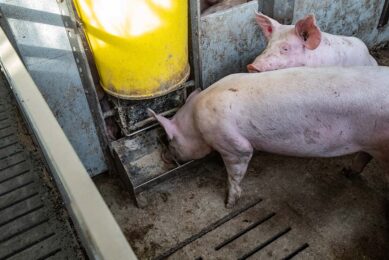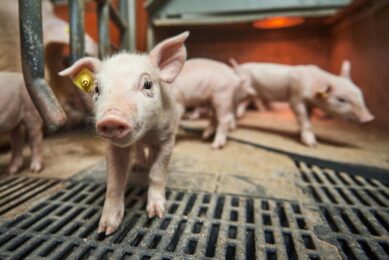Sustainability in breeding: It all depends on the definition

Every time the word ‘sustainability’ is being called upon, it is necessary to carefully consider what the term means exactly. That also holds true for genetic and breeding issues. Depending on how to define sustainability, a good path for the future can be designed. Different stakeholders should be involved to explore potential options.
Sustainability is a word that pops up in numerous areas nowadays, also in breeding. Sometimes more traditional farming is considered more sustainable than modern farming, but the actual measuring of a variety of footprints allows for a more objective comparison. ‘Sustainable’ is a term that covers a wide range of different aspects: profitability, productivity, environmental soundness (from resource efficiency, water usage, animal welfare, and antibiotic usage to transport), biodiversity, social viability and ethical aspects. Different components that cannot be added up easily.
The overall long-term direction in food production seems to be focused more and more at sustainability. Consumers request products that are part of a sustainable production environment. Mass production of anonymous products is no longer favoured, not even if the price is the most competing price available. High-tech techniques like Genetically Modified Organisms (GMO) might be accepted by some consumer groups, but are rejected by others. Consumers like a product that is produced with respect. A natural product that is not fooled around with. A product that comes with a matching story and eating experience. This makes it necessary for breeding organisations and producers to focus more on a balanced approach with respect for people, animals and the planet, see Figure 1.
Figure 1 – Sustainability triangle.

Overall sustainability index
It is not easy to get an overall sustainability index for a certain product, but extremes are not appreciated. If one component is out of range the product is regarded as less sustainable. For example antibiotic residues at a too high level, extreme logistics or doubtful follow up of animal welfare regulations can make a very sustainable animal product rejected easily by the public opinion.
On the short-term, a component like profitability might get overemphasised in comparison to other components. But finding food is for most people no longer just a need to cover basic nutrition requirements, but is developing into the buying of a kind of luxury good. Consumers do not just buy food, they want to experience food. Food nowadays has to come with a story. One wants to know the history of production, compare taste and feel good about the way it is produced and treated. Pure and natural ingredients are in, artificial ingredients are seen with suspicion. Finally, branding a product combined with tracking and tracing seems to be the way to build the product’s story and experience.
And what about breeding?
At the end it is logical that breeding organisations consider various components of sustainability in their breeding goals. They are part of society and they are being watched intensively by critical consumers. A part of sustainability comes easily and goes hand in hand with improved economics. A long-term vision is a logical intrinsic component of a breeding goal.
Other parts represent consumer acceptance and quality. It is extremely difficult to predict consumer preferences for the future. Also consumer reactions are hard to predict. It is very much like a weather forecast, the further we look ahead, the more assumptions have to be made and the more potential scenarios could be worth considering. For breeding goals it is not new to deal with this type of uncertainty. Results have to be continuously matched with actual situations for customer experience, competitor position, etc. It could completely change the breeding programme. Like in layer breeding where finding or not finding a consumer-accepted solution for the surplus male chickens, can have serious impact on the breeding goal definition in the near future.
Weaning capacity
Also pig breeding companies have their long-term vision. Breeding is thinking generations ahead. What is ‘sustainability’ at the end? The market will judge on it. Sometimes consumers sometimes farmers will have an important say on whether a scenario gets accepted or not. It is difficult for outsiders to understand what the impact of various scenarios will be. Sustainability can be judged on the impact it has on resources and environment. But other aspects of sustainability are more related to ethics and animal welfare. For example, whether a sow and her offspring remain in balance and can survive without too much interference from others.

An example is litter size. What can be seen are scenarios in which litter size has increased enormously and the sow’s capacity to wean the piglets is lacking behind. The mother sow cannot take care of her own produced litter anymore. She lacks weaning capacity. When these lactating sows would have to wean their own piglets, a lot of the piglets die in the pre-weaning phase. Sows are more or less used as pig production machines. That does not seem to represent a very sustainable scenario.
It is more logical is to understand that increased piglet numbers require increased numbers of teats and increased milk production. In that way it’s possible to see that sows can bring more piglets, but probably still have less difficulty to wean larger numbers of piglets than sows from generations before had with much smaller litters. Less interference means lower investments, fewer antibiotics and a consistently better farm performance under more natural circumstances. It also means a more natural environment for sows and pigs and an increased welfare.
Efficiency or quality?
Litter size is just one aspect. In most markets the breeding goal focuses on leaner and more efficiently growing animals. At the end it means more meat for less feed. This represents efficiency, but not always necessarily, it also brings the quality of meat the market wants. Meat quality has a negative correlation with leanness and efficiency. Meat quality is a characteristic that is not easy to value for consumers. Leaner meat can go together with less water holding capacity of the meat. Extreme animals like Piétrains are in many cases still carrier of a major gene called the Ryanodine Receptor (RYR1) gene. This gene is also called the stress or ‘Halothane gene’. Breeding animals used to be tested with halothane gas to detect pigs with a typical reaction. They were homozygous carriers of the undesired recessive stress gene.
In the early 1990s this test was one of the first replaced effectively with a DNA-test. The stress gene causes lower water binding capacity and Pale Soft Exudative (PSE) pig meat. In supermarkets they sometimes correct this issue by puttng water absorbing patches in the trays of fresh pork. When mince or derived products are the marketed product, lean meat can easily be up- and downgraded by adding fatter cuts. Especially for sausage market meat quality in this way will hardly be an issue.
Overall tendency in worldwide pork production
The overall tendency in worldwide pork production is breeding towards higher efficiency and improved leanness. The global genetics market is dominated worldwide by a handful of global players. Most of them focus heavily on efficiency. Most of them increased the investments in feed stations and biotechnology in the latest decade. And their focus remains on leanness and efficiency. Table 1 gives an example about improvement trends in the latest 50 year time-span. Daily gain almost doubled and the amount of kilogrammes of feed needed to produce meat decreased from 3.2 kg to 2.15 kg.
Not all markets are interested in the leanest piece of meat. Some markets want the pure taste of pork and value the real fresh pork. Examples are here the Japanese and Korean markets. The people of those countries have developed a flavour perception that goes beyond the normal appreciation of meat quality and off-flavours in western societies. In these markets meat quality is really appreciated and pig breeds with extreme good meat quality like Duroc and Berkshire are extensively used in the sire line market. They have been bred even more extreme and are nothing like their North American or European breed equivalents. Most extreme in meat quality are the local varieties of breeds like Berkshire known as ‘Kurobuta’ (black pigs).
Meat quality and sustainability
Coming back to sustainability: attention to flavour and meat quality does not necessarily lead to a more sustainable pig production. It creates premium products for a specialised market. But it creates products with a direct match in the market, a luxury product treated with respect and appreciated much more than an anonymous piece of mass-produced meat. Special sire breeds are used for this product and sometimes the concept is completely produced in the US or Canadian market (for example the Nagano-pig) for export to Japan.
A direct match between product and its target market makes the breeding focus efficient. And high quality also leads to full utilisation of all cuts, which adds again to overall sustainability. For a community eating less of a luxury type of meat will be even more sustainable than eating the most efficient mass-produced meat. It is not easy to predict, but future generations might prefer to eat much less meat with an increased perception of taste and quality. The overall picture can become much more sustainable than with today’s western meat consumption.
Balancing footprints and other sustainability factors
The main emphasis in breeding goals is on maximised output and improved efficiency. Genetic programmes have led to increased production efficiency and decreased impact on the environment per kg produced meat. Conventional genetic programs based on Best Linear Unbiased Prediction (BLUP) breeding values have led to continuous improvements that are going to be accelerated by new techniques like Genomic Selection. By applying genomic selection, the environmental footprint of pork production can be reduced drastically in the coming 50 years. Overall reductions of up to 27% in greenhouse gases, up to 44% less acidification and almost 58% less eutrophication seem to be achievable. In most cases an improvement from 30 to 65% (Table 2).
But sustainable pork should not just be measured by efficiency and environmental impact per kg of meat produced. Sustainability is a combination of sustainable breeding, sustainable farming, sustainable meat products and sustainable meat consumption. It certainly requires a lower impact on nature, a lower carbon footprint and lower water footprint. It comes as well with a focus on full utilisation of pig carcasses and local production. A transparent production chain where consumers know what happens with the pigs and can check it themselves. Complete openness on antibiotics and treatments, etc. And what about breeding or genetics? Genetics has to complete the picture. Once production circumstances, consumer meat products and consumption patterns are well defined, genetics can fill in the last part by providing the best match between the animal and the requested consumer product. Within the specification it can optimise efficiency, product robustness, meat quality and other favourable specification points.
GMO and sustainability?
Can genetically modified organisms help with sustainability? When it makes the next generations more efficient, more disease resistant, etc., some people will consider it sustainable, while others will reject is as being unnatural with a difficult to estimate impact on the future environment. Carefully implemented genomic technologies may provide new solutions to complete the picture of future sustainability. It should not be rejected upfront, but it will be a difficult discussion, because fear of potential future negative impact on environment cannot easily be contradicted.
Sustainable is not to make the most efficient protein pulp. In the future fewer people will be interested in mass protein products and will prefer to consume less and will demand higher product quality. Focusing on this, the future market requires careful listening to consumer trends and matching products with the market. New pork concepts that no longer depend on ordinary mass meat production will be required. Customers might better appreciate 100 g Kobe beef than 1,000 g of sausage.
Consumer appreciation should be part of sustainability
Future breeding goals can no longer afford a single focus on maximum output and efficiency. It is not only a measurable footprint, but sustainability comes with a total picture which includes genetics, farming, meat production and consumption. Sustainability should not be always expressed per kg of meat, but in consumer appreciation. The total impact on people, animals and planet should be taken into account. Non-economic objectives and more intense appreciation should get their weight in the scale when it comes to overall sustainability measurements.
Join 18,000+ subscribers
Subscribe to our newsletter to stay updated about all the need-to-know content in the pigsector, three times a week. Beheer
Beheer









 WP Admin
WP Admin  Bewerk bericht
Bewerk bericht